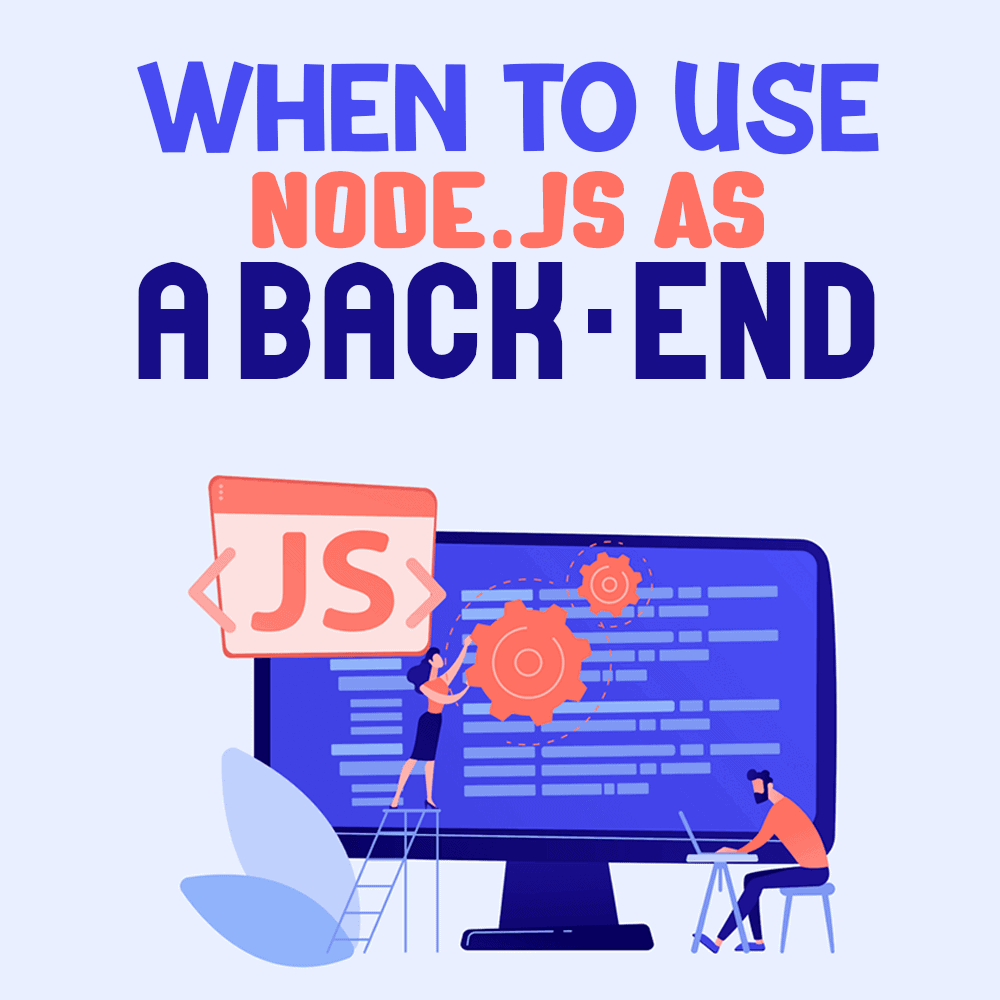
On the web, the status of JavaScript is even more prominent. It de facto powers the majority of web applications that are available in your Chrome (or any of its derivatives) or Firefox browser. After all, the platform was specifically developed for the creation of web applications. JavaScript is everywhere in your life.
You would have been unable to find a job or watch a favorite movie without this programming language. Some of the most popular websites developed with the help of JavaScript include Netflix, Facebook, and LinkedIn.
However, the limited nature of JavaScript created many problems for developers. A server-side application for the JavaScript website had to be written in a different programming language. This feature created several significant issues for the firms that utilized JavaScript.
Firstly, they had to bear the costs of hiring two programming teams—one for the back-end and another for the front-end. Apart from higher costs, such a subdivision of a company created the potential for conflicts between separate teams.
Secondly, the lack of a back-end JavaScript solution created a high probability of compatibility problems. Even though the majority of them were easy to resolve, their gradual accumulation could easily make specific web applications laggy and bug-ridden.
The appearance of Node.js in 2009 changed the situation entirely. After all, the platform represents a full-scale runtime environment for the JavaScript language, which is comparable to Java Virtual Machine and the Integrated Development and Learning Environment of Python.
Thus, Node.js offered limitless opportunities for developers. For the first time, it could be used anywhere. There is only one question left to ask: When should it be used for developing the back-end of web-based products? This is what we’ll be tackling in this post: three major cases when Node.js should be the technology of choice for back-end development.
Node.js as a Back-End: Key Use Cases
Despite all the benefits it offers, Node.js is neither a panacea nor a one-size-fits-all solution. There are cases when it is a perfect choice for back-end development and cases when you should opt for a different programming language. So, here, I will shed light on three use cases when Node.js is the number one choice.
Use Case 1. You Need To Enable Full-Stack JavaScript Development for Creating Bug-Free, Secure, and Easy-to-Maintain Web-Based Solutions
Node.js was created with back-end development in mind. Essentially, its creators intended it to be a pure back-end solution. Thus, it acts as a perfect addition to the myriad of existing JavaScript tools on the market. If your web application is already based on JavaScript, the transition to JavaScript servers via Node.js makes sense.
Firstly, it will remove the common problems of software updates. With full-stack JavaScript development, the amount of time your developers will spend on pushing upgrades to your web applications will decrease significantly.
Secondly, the unified framework will likely reduce the number of critical bugs and security gaps that can arise during the interaction between the more classical server-client arrangements. Thus, if your web apps deal with sensitive user information, the transition to JavaScript back-end can genuinely be a game-changer if you already have a full-scale JavaScript front-end.
Similar logic applies to the new web apps that are likely to use JavaScript for front-end development. The Node.js back-end can significantly decrease the complexity of your future code, helping you to deliver a more coherent—and consequently, promising—initial version of your product.
Use Case 2. You Want To Significantly Decrease Development Costs of Your Web-Based Solutions

A JavaScript back-end team will likely end up being smaller and will require less experienced programmers to operate than a Python or C# one. If you actually go for full-stack, you can even abandon the divide between back-end and front-end teams, creating a genuinely unified development environment.
The developers and community of Node.js facilitate such development choices because the runtime environment has an expanding set of tools that can assist you with front-end development. For instance, the so-called Pug offers a Node.js template engine that can transform the server-side back-end data into HTML strings that will be easy to render on the client’s PC.
If you are constrained when it comes to resources (for instance, your company is a small startup, or you are a lone developer), Node development may be your only viable solution. It is simple and easy-to-learn and requires rather modest development teams even in back-end development.
The runtime environment is even robust enough to enable development outside of the web, with some of the most unique use cases, including robotics. Thus, Node.js can offer you a perfect way to save money without losing the efficiency or security of traditional development-oriented solutions.
Use Case 3. You Seek To Create Programs That Will Deal With a Large Number of User Inquiries
One of the primary advantages of Node.js is its support of single-threaded processing. Node.js utilizes it to an utmost extent, being a de facto “king” of asynchronous single-threaded computing in the modern world.
A Node.js JavaScript back-end is a perfect solution for servers that are likely to encounter a massive influx of users who will not have significant computational needs. Consequently, it can process all of the client inquiries within one thread without having to resort to creating separate instances for all of them.
In practice, this means a more efficient use of both the client and server-side CPU capabilities. Node.js back-end will be less taxing on your server than other popular back-end solutions in the outlined use case. For instance, if you choose to create a web chat, your back-end will likely have to handle hundreds if not thousands of user requests.
Traditional multithreading can bottleneck your performance, since the number of threads tends to be rather limited. Node.js will significantly increase the capacity for processing user inquiries, as different client requests can even share some of the variables within the runtime environment.
A typical computational load of a chat or even a simplistic web game is usually rather limited when it comes to the back-end. Consequently, Node.js will significantly increase your capacity to build scalable solutions for a large number of users. The Node.js use cases are endless today. Back-end Node.js solutions are actively used in many areas today:
- Web chat development
- Creation of simple web-based games
- Social media sites (for instance, Facebook)
- Video streaming websites such as Netflix
- Online document editing applications
- Various database applications aimed at providing small bits of information to users (web applications for stock exchange brokers already use Node.js to drive financial innovations)
Moreover, the single-threaded computing advantage will stay even if you choose to avoid JavaScript for front-end solutions. Thus, you will be able to easily extend the critical benefits of JavaScript to smartphone or even desktop application development.
When You Should Avoid Node.js in Back-End Development
As I have noted, the primary strength of Node.js is its single-threaded nature. It significantly decreases the complexity of handling various requests when you have hundreds, thousands, or even hundreds of thousands of users with limited requests when it comes to sheer computational power.
The trend shifts significantly when you have a small number of client-side requests that, however, demand significant computational power. Let us imagine a situation in which you build a complex web application for rather complicated mathematical calculations. In specific scenarios, even two simultaneous inquiries can quickly overload your server CPU.
Only multithreading can offer you a robust solution to the problem, as it will dedicate more “firepower” to complex processes, immediately initializing calculations on multiple cores of a CPU.
However, this situation is highly hypothetical. The majority of the programs that involve heavy calculations are always desktop-based. The complexity of the calculations is often so high that even the multithreading server back-ends cannot deal with a relatively small number of user inquiries.
It is easier to offload all calculations to user PCs, making offline programs for some of the most complex tasks such as video rendering or mathematical calculations. Thus, I do not recommend that you use web platforms for any type of complex calculations. This situation may change in this decade; however, the future solution is likely to involve some radical innovations. Node.js is clearly not an option in this case.
Node.js is a niche product that is oriented at the everyday needs of non-advanced PC users; if you go outside of this safe zone, you are essentially shooting yourself in the foot. Complex calculations should be dedicated only to classical development solutions.
Node.js: The Dream Framework

- If you are an entrepreneur, the use of the Node web development services can offer you a perfect opportunity to cut costs in web development.
- If you are a web developer, Node.js can serve as a perfect path toward full-stack JavaScript development.
Few platforms can offer such robustness in the development world. Thus, I really recommend Node.js for all types of web development.
Node.js is a dream framework for any developer who seeks to create secure and scalable back-ends. More importantly, it also has sufficient tools to enable simple front-end development.
You should try learning JavaScript and use Node.js regardless of your specialization. Due to the simplicity of both solutions, you can get an easy addition to your developer portfolio if you choose to do so.
